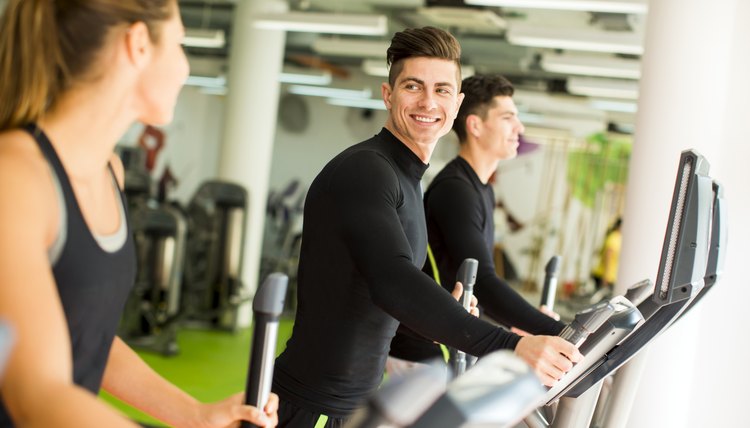What Is a Fit Test on a Lifecycle Treadmill?

When shopping for a treadmill you'll often look for basic features such as the type of motor, the size of the machine and the ability to change incline and speed. Another helpful feature of electronic treadmills is installed programs that automatically adjust speed and incline as you exercise. On certain Life Fitness treadmills, the programs also include a Fit Test. This test is also included on some models of the Life Fitness brand of stationary bikes called Lifecycle. Knowing how to use this feature and what it can tell you, allows you to monitor your fitness goals.
Fit Test Measurements
Performed regularly, the Fit Test provides an indication of your cardiovascular improvement over time. The test monitors your heart rate to determine how well your heart sends oxygen to your working muscles and how readily your muscles use that oxygen. Aerobic exercise improves cardiovascular strength. With regular use of the Fit Test, you should see your heart rate decreasing as your heart becomes more efficient and better at delivering oxygen to your body. However, overtraining can lead to an increase in heart rate so the Fit Test is also a way to monitor whether or not you're overdoing it.
Fit Test Preparation
Although many models of Lifecycle treadmills feature the Fit Test, accessing the test is not the same on every machine. On some machines, the test is located under the Advanced Workout settings, while other machines have a dedicated button for the Fit Test. Your user manual will tell you which buttons to press to find the feature. Once you find the feature, you'll enter your age, weight and gender. If your treadmill does not have heart rate sensors on the treadmill hand grips, you'll need to wear a heart rate monitor that may be included with your treadmill.
Fit Test Timing
To get a baseline measurement, you'll want to perform a Fit Test once you become comfortable on your Lifecycle treadmill. Lifecycle then recommends you perform a Fit Test every four to six weeks. Because the test requires you to get your heart rate up to 60 to 85 percent of maximum, get your doctor's approval before performing the test if you have any cardiovascular problems.
Fit Test In Action
Once you have your Fit Test set up, you'll choose a speed that is appropriate for your age and fitness level. Once you tell the machine to start the test you will run or walk on a level surface for one minute to warm up. The treadmill will then change to a 5 percent incline for four minutes. Toward the end of the test, the machine will take your heart rate through the heart rate monitor or the hand grips and give your your Fit Test score. You can then compare this score to the chart in your user manual to judge your fitness level. If using the Fit Test on the Lifecycle exercise bike, your scores will be about 10 to 15 percent lower than on the treadmill since most of the effort is focused on your quadriceps.
Fit Test Considerations
To get the most accurate results from your Fit Test, try to be as consistent as possible. Because your heart rate fluctuates based on stress, time of day, when you last exercised and what you've recently had to eat or drink, changes in any of these factors can give an inaccurate Fit Test score. Whenever you take the test, make sure it is the same time of day and that you've had at least seven hours of sleep the night before. Also, try to take the test at least six hours after your last workout and four hours after having any caffeine or alcohol.
Writer Bio
Based in Portland, Ore., Tammie Painter has been writing garden, fitness, science and travel articles since 2008. Her articles have appeared in magazines such as "Herb Companion" and "Northwest Travel" and she is the author of six books. Painter earned her Bachelor of Science in biology from Portland State University.
